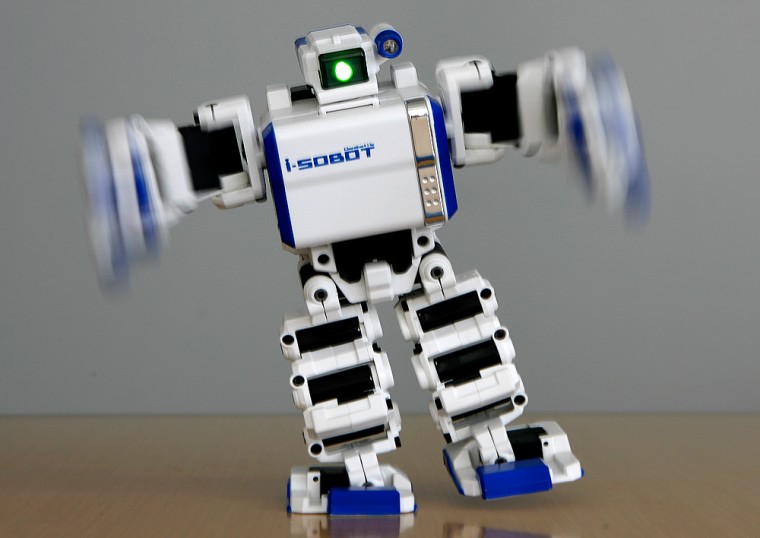Relatively affordable at $300, i-Sobot has 17 motors, can recognize spoken words and be controlled remotely, making the walking, somersaulting, karate-chopping robot as close to a humanoid as toys get.
And it has a key feature any human would love: There's no assembly required.
Robots that look like people are now available from Kondo Kagaku Co., Kyosho Corp. and others.
But they cost $1,000 or more and usually require grueling hours of piecing together motors, metal frames and wiring and then painting. And they must be programmed with a computer — an endeavor so delicate it's hard to get the machines to walk straight without falling over their own feet.
With all the labor required, the more sophisticated robots start to grow on their owners: There's a thrill when they finally move, almost like make-believe children. Even better, the futuristic Nuvo from Japanese robot maker ZMP Inc., which costs about $5,500, comes fully assembled.
I-Sobot isn't perfect, even as a toy. Although it's designed to recognize 10 voice commands, such as "Look out," and "How are you?" it often fails to respond properly.
On the upside, it's been programmed to apologize when that happens.
The 6.5-inch-tall i-Sobot from Japanese toy maker Tomy Co. is good for lots of laughs, with its repertoire of some 200 preprogrammed patterns of movements, including an air guitar routine in which its tiny plastic arms move in time to Hendrix-like sound effects.
I-Sobot even mimics a chicken, clucking and bending forward to peck at the ground while holding its arms out like wings. It looks amusing too, with a Cyclops-like light in the center of its square head and a blinking blue light on the side.
The device, whose name is based on the Japanese words for "love" and "play," speaks 180 words and phrases and can play both roles in an abbreviated Romeo and Juliet garden scene.
Whether a companion robot designed for people age 15 or older will catch on outside gadget-loving Japan is a big test for Tokyo-based Tomy, which also makes Transformer and Penny Racer toys for younger children.
Recognized by Guinness World Records as the smallest humanoid robot in commercial production, i-Sobot went on sale in Japan, in white, and the U.S., in black, this fall and is set to arrive in Europe next year.
A joystick on the remote makes i-Sobot walk forward, backward and sideways, and turn left or right. Pushing the remote's buttons in different combinations gets the robot to carry out preprogrammed moves.
Pushing the "2" button twice, then the "K" button, produces a kung-fu kick, which i-Sobot performs nicely, maintaining its balance on one leg, helped by a built-in gyro-sensor. Push "2-3-2-B," and it gets down for push-ups.
It also says, "I love you," holding its arms out, and can wish you "Happy birthday" and sing the final few notes of the celebratory tune.
An accompanying booklet includes a menu of the movements. By combining a series of them, you can create an original theatrical shtick or dance choreography, though i-Sobot can't be programmed with new positions like the more expensive kit robots.
I-Sobot also doesn't know its surroundings, recognize faces or remember experiences like the more sophisticated robots. It's not as smart as Sony Corp.'s discontinued Aibo dog-robot, which came with a digital camera that enabled it to recognize and chase a pink ball. (Some people became emotionally attached to Aibos for the illusion of spontaneity they delivered.)
What's pleasantly disarming about i-Sobot is that its creators didn't take themselves too seriously.
Among my favorite moves is a slow rigid march, in which each step is matched with a tiny explosive sound evocative of a giant robot stomping.
